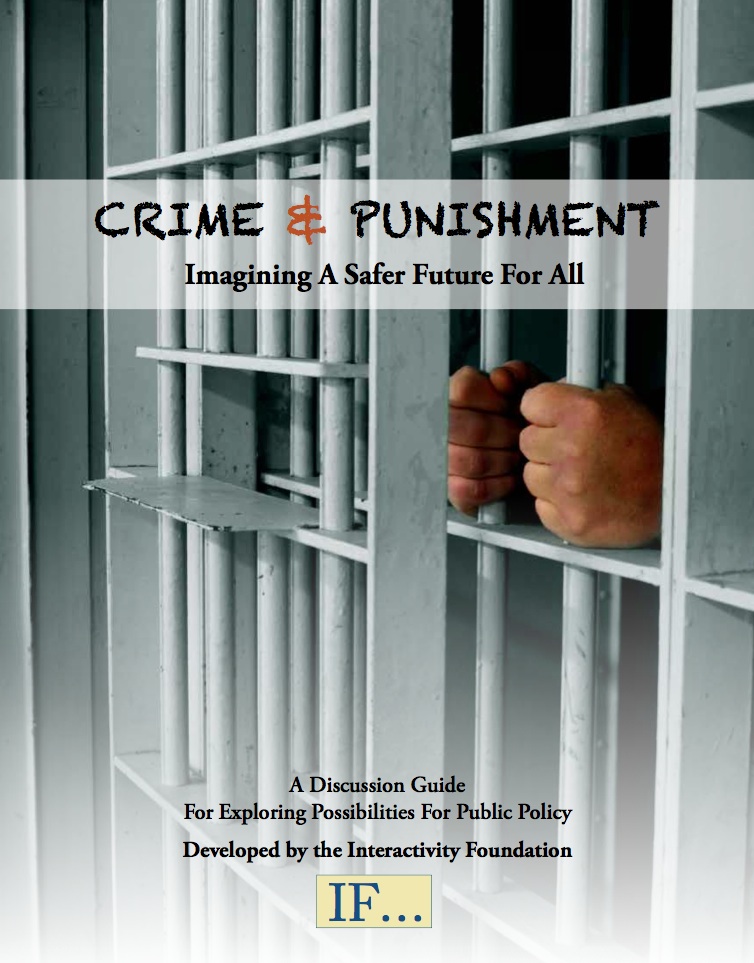Crime & Punishment is one of the Interactivity Foundation’s most recently published discussion guides. This guidebook presents five broad “possibilities” or frameworks for public policy for addressing the current and future challenges of our criminal justice system.
Although there is no single possibility among the five that is solely concerned with issues of racial discrimination and civil rights, these issues are inextricably intertwined with every aspect of our crime and punishment policies and with each of the five possibilities. In fact, in the view of those who contributed to the development of this guidebook, race—and to only a slightly lesser extent economic class—is so central to how we define, enforce and punish crime that it is impossible and misleading to separate it into a single possibility. Instead, issues of racial discrimination and civil rights are, sadly, part of the whole and every part of Crime & Punishment just as harmful bacteria are present everywhere in the world around and within us: in the air, water, soil, on our skin and in our bloodstream.
Some troubling trends are noted in the opening sections of the Crime & Punishment guidebook—
- At current rates, one third of all black men without a college education and 60% of those who don’t finish high school will be incarcerated at some point in their lives.
- In larger U.S. cities, black men are more likely to go to prison than college.
- The United States is the world leader in the rate at which it incarcerates its citizens, and that rate is nearly 5 times higher than historic norms and 7 times higher than other developed countries.
- The incarceration rate for African Americans is nearly 6 times the rate for whites. And for drug crimes, the incarceration rate for blacks is 9 times that for whites even though rates of illegal drug use vary by only a single percentage: 9% for whites, 10% for blacks.
- While the overall homicide rate for all Americans has declined by half since 1991, the gun homicide rate for black men has increased. Young black men are now 40% more likely to be killed by gun than they were in 1991.
- The U.S. incarcerates a larger percentage of its black population than South Africa did during apartheid, and there are now more African American adults under correctional supervision in the U.S. than were enslaved in 1850.
- And as a consequence of this policy of mass incarceration, there are now more black men who are unable to vote than there were in 1870, the year the 15th amendment was ratified.
With these and other trends, it’s rather difficult to see how we’re achieving success in securing civil rights for all Americans or when we might be living in any kind of post-racial society.
But to acknowledge the horrible universality and enduring (or even growing) scourge of racial discrimination should not be viewed as accepting or giving into the disease. The rule of law in general and our civil rights laws in particular are (or should be) meant to combat this disease and inoculate us against some of its worst symptoms and their spread. We must do better—especially when it comes to our criminal justice system, for in order to treat each other fairly and with dignity in our everyday interactions, we absolutely must do so in our most critical criminal enforcement and penal policies. Throughout the discussion guidebook on Crime & Punishment and its five policy possibilities are a number of alternative and contrasting ideas for combating racial discrimination, including—
Cutting the school-to-prison pipeline by reducing or banning the many “no tolerance” school policies that criminalize juvenile behaviors. Fortunately, it looks as though this approach is already being tried. See the Dec. 2, 2013, New York Times article “Seeing the Toll, Schools Revise Zero Tolerance.”
- Providing greater support for improving education, providing health care, and a national jobs program.
- More and better drug and mental health treatment programs in lieu of prison for non-violent offenders with those problems.
- Roll back much of the “War on Drugs”:
- Eliminate or moderate 3-strike laws and other determinant sentencing laws: give judges back the ability to adjust the sentences to the individual facts of each case.
- Reduce the length of sentences for non-violent drug offenses back to historic norms.
- Reduce or eliminate the post prison sanctions that make it more difficult for ex-cons to find and hold jobs and otherwise reintegrate. For example, eliminate the provisions that allow for or require discrimination against ex-cons in employment, housing, professional licensing, financial aid for education, etc.
- Reduce or eliminate the compounding civil fines and penalties that have been added to many prison sentences.
- Allow ex-cons to vote upon release from prison.
- Shift funding from high tech enforcement and drug task forces to treatment programs, community policing, and jobs programs.
- Re-focus policing and enforcement policies away from the easy arrest (“stop and frisk”) for low-level drug and street crimes and focus on the few “high volume” and more violent offenders (“focused deterrence”).
- Sustain a national and long-term conversation on our how our criminal justice system and policies interact with issues of race, class, and civil rights.
- Evaluate all enforcement and penal policies to determine whether they have (or will have) a disparate racial impact; and work to craft and implement more neutral and effective policies.
Alone or even combined these and other suggested measures won’t be nearly sufficient to insure the civil rights of all our citizens in our criminal justice system or in general. But they may help to reduce some of the disparities and bring us closer to a more just justice system.
For more information or to download a copy of the Crime & Punishment discussion guide, see the Crime & Punishment discussion page on the Interactivity Foundation website.
